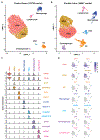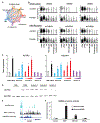Single-cell multiomics guided mechanistic understanding of Fontan-associated liver disease
- PMID: 38657025
- PMCID: PMC11103255
- DOI: 10.1126/scitranslmed.adk6213
Single-cell multiomics guided mechanistic understanding of Fontan-associated liver disease
Abstract
The Fontan operation is the current standard of care for single-ventricle congenital heart disease. Individuals with a Fontan circulation (FC) exhibit central venous hypertension and face life-threatening complications of hepatic fibrosis, known as Fontan-associated liver disease (FALD). The fundamental biology and mechanisms of FALD are little understood. Here, we generated a transcriptomic and epigenomic atlas of human FALD at single-cell resolution using multiomic snRNA-ATAC-seq. We found profound cell type-specific transcriptomic and epigenomic changes in FC livers. Central hepatocytes (cHep) exhibited the most substantial changes, featuring profound metabolic reprogramming. These cHep changes preceded substantial activation of hepatic stellate cells and liver fibrosis, suggesting cHep as a potential first "responder" in the pathogenesis of FALD. We also identified a network of ligand-receptor pairs that transmit signals from cHep to hepatic stellate cells, which may promote their activation and liver fibrosis. We further experimentally demonstrated that activins A and B promote fibrotic activation in vitro and identified mechanisms of activin A's transcriptional activation in FALD. Together, our single-cell transcriptomic and epigenomic atlas revealed mechanistic insights into the pathogenesis of FALD and may aid identification of potential therapeutic targets.
Conflict of interest statement
Figures






References
-
- Schilling C, Dalziel K, Nunn R, Du Plessis K, Shi WY, Celermajer D, Winlaw D, Weintraub RG, Grigg LE, Radford DJ, Bullock A, Gentles TL, Wheaton GR, Hornung T, Justo RN, d’Udekem Y, The Fontan epidemic: Population projections from the Australia and New Zealand Fontan Registry. Int J Cardiol 219, 14–19 (2016). - PubMed
-
- Rychik J, Atz AM, Celermajer DS, Deal BJ, Gatzoulis MA, Gewillig MH, Hsia TY, Hsu DT, Kovacs AH, McCrindle BW, Newburger JW, Pike NA, Rodefeld M, Rosenthal DN, Schumacher KR, Marino BS, Stout K, Veldtman G, Younoszai AK, d’Udekem Y, American Heart Association Council on Cardiovascular Disease in the, C. Council on, N. Stroke, Evaluation and Management of the Child and Adult With Fontan Circulation: A Scientific Statement From the American Heart Association. Circulation, CIR0000000000000696 (2019). - PubMed
-
- Rychik J, Forty years of the Fontan operation: a failed strategy. Semin Thorac Cardiovasc Surg Pediatr Card Surg Annu 13, 96–100 (2010). - PubMed
-
- Dennis M, Zannino D, du Plessis K, Bullock A, Disney PJS, Radford DJ, Hornung T, Grigg L, Cordina R, d’Udekem Y, Celermajer DS, Clinical Outcomes in Adolescents and Adults After the Fontan Procedure. J Am Coll Cardiol 71, 1009–1017 (2018). - PubMed
Publication types
MeSH terms
Grants and funding
LinkOut - more resources
Full Text Sources
Medical
Molecular Biology Databases
Research Materials

